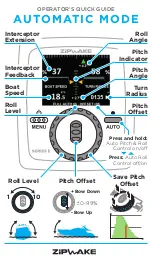
6
ENGLISH
BACK TO TOC
Table 1D. Post-Operative Adverse Events > 2 Weeks – 1 Year
Adverse Event
NovaSure
n=175(%)
Loop Resection
Plus Rollerball
n=90 (%)
Hysterectomy
3 (1 .7%)
2 (2 .2%)
Hematometra
1 (0 .6%)
2 (2 .2%)
Urinary tract infection
2 (1 .1%)
2 (2 .2%)
Vaginal infection
5 (2 .9%)
2 (2 .2%)
Endometritis
2 (1 .1%)
1 (1 .1%)
Pelvic inflammatory disease
2 (1 .1%)
0
(0 .0%
Hemorrhage
1 (0 .6%)
0
(0 .0%
Pelvic pain/cramping
5 (2 .9%)
6 (6 .7%)
TOTAL
21 (12 .0%)*
15 (16 .17%)**
* 21 events in 19 (10 .9%) patients
** 15 events in 15 (16 .7%) patients
Anticipated Post-Procedural Complications
For any endometrial ablation procedure, commonly reported post-
operative events include the following:
• Cramping/pelvic pain was reported for 3 .4% of the NovaSure patients
and 4 .4% of the wire resection loop plus rollerball-treated patients
within 24 hours of the procedure . Postoperative cramping can range
from mild to severe . This cramping will typically last a few hours and
rarely continues beyond the first day following the procedure .
• Nausea and vomiting were reported for 1 .7% of the NovaSure patients
and 1 .1% of the wire loop resection plus rollerball patients within
24 hours of the procedure . When present, nausea and vomiting
typically occur immediately following the procedure, are associated
with anesthesia and can be managed with medication .
• Vaginal discharge
• Vaginal bleeding/spotting
Other Adverse Events
As with all endometrial ablation procedures, serious injury or death can
occur .
The following adverse events could occur or have been reported in
association with the use of the NovaSure system:
• post-ablation tubal sterilization syndrome
• pregnancy-related complications
(NOTE: PREGNANCY FOLLOWING
ENDOMETRIAL ABLATION IS VERY DANGEROUS FOR BOTH THE
MOTHER AND THE FETUS.)
• thermal injury to adjacent tissue
• perforation of the uterine wall
• difficulty with defecation or micturition
• uterine necrosis
• air or gas embolism
• infection or sepsis
• complications leading to serious injury or death
Clinical Study
Purpose:
Safety and effectiveness of the use of the NovaSure system
was compared to wire loop resection of the endometrium followed by
rollerball ablation in premenopausal women suffering from menorrhagia
secondary to benign causes .
Pretreatment:
Patients randomized into the NovaSure arm received
no endometrial pretreatment (e .g ., hormone, D&C or patient timing) .
Patients randomized into the control arm received wire loop resection as
an endometrial pretreatment .
Study endpoints:
The primary effectiveness measure was a validated
menstrual diary scoring system developed by Higham (Higham JM,
O’Brien PMS, Shaw RW
Br J Obstet Gynaecol
1990; 97:734-9) .
Assessment of menstrual blood loss was performed using a pictorial
blood loss assessment chart (PBLAC) . Patient success was defined as
a reduction in menstrual flow at 1 year post-procedure to a diary score
of <75 . Study success was defined as a statistical difference of less
than 20% in patient success rates between the NovaSure impedance
controlled endometrial ablation system and wire loop resection plus
rollerball ablation . Patients were contacted at two and three years and
asked a series of questions regarding their bleeding over the previous
12 months . Each patient’s menstrual bleeding status was determined
at two and three years using the one-year PBLAC score and bleeding
pattern as a reference . Thus, it was possible to directly compare a
patient’s bleeding pattern or menstrual status at one year to the bleeding
pattern at two and three years .
Secondary endpoints included anesthesia regimen, length of procedure
and responses from a quality-of-life questionnaire . Safety evaluation was
based on the adverse events reported during the study .
Methods:
A randomized (2:1), prospective clinical study was conducted
at 9 clinical sites and included 265 patients diagnosed with menorrhagia .
Menstrual diary scores were collected pre-operatively and monthly for
12 months post-procedure . Patients were treated at any time in their
menstrual cycle . None of the patients received hormonal pretreatment
to thin the endometrial lining . Control patients received hysteroscopic
wire loop resection of the endometrium as a mechanical means of
endometrial pretreatment followed by rollerball ablation . Study subjects
were required to meet the following key patient selection criteria:
Inclusion criteria
• Refractory menorrhagia with no definable organic cause (dysfunctional
uterine bleeding)
• Ages 25 to 50 years of age
• Uterine sound measurement of 6 .0–10 .0 cm (external os to internal
fundus)
• Minimum PBLAC score of >150 for 3 months prior to study enrollment;
or PBLAC score >150 for one month for women who:
- had at least 3 prior months (documented) failed medical therapy;
- had a contraindication to medical therapy; or
- refused medical therapy .
Summary of Contents for NovaSure Advanced
Page 1: ......
Page 31: ...MAN 03523 001 Rev 009...








































